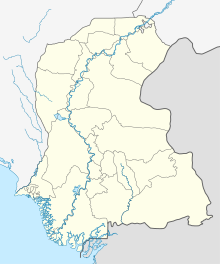| Revision as of 07:38, 22 December 2024 editVeritasphere (talk | contribs)Extended confirmed users, Rollbackers9,359 editsNo edit summaryTags: Visual edit Mobile edit Mobile web edit Advanced mobile edit← Previous edit | Revision as of 07:40, 22 December 2024 edit undoVeritasphere (talk | contribs)Extended confirmed users, Rollbackers9,359 editsNo edit summaryTags: Mobile edit Mobile web edit Advanced mobile editNext edit → | ||
| Line 23: | Line 23: | ||
| ] | ] | ||
| ] | ] | ||
| ] | |||
| ] | |||
Revision as of 07:40, 22 December 2024
| Second Battle of Makli | |||||||
|---|---|---|---|---|---|---|---|
| |||||||
| Belligerents | |||||||
| Kalmat (Karmat) Tribe | Jokhia Tribe | ||||||
| Commanders and leaders | |||||||
| Mir Mazar Khan † | Jam Bajar | ||||||
 | |||||||
The Second Battle of Makli (Sindhi: مڪلي واري ٻي جنگ) was fought during the Talpur dynasty's reign in Sindh between the Baloch Kalmat (Karmat) tribe and the Sindhi Jokhia tribe at the Makli site.
Background
Following the First Battle of Makli, a series of killings and violence ensued for several years. Nineteen years later, a second battle was fought at the Makli site. The ruler at the time, Mir Fateh Ali Khan Talpur, attempted to halt the conflict but failed.
On a winter morning, 6 Jumada al-Awwal 1203 AH, corresponding to 2 February 1789, the battle was fought between the Jokhias and the Kalmats. Similar to the first battle, Jam Bajar led the Jokhia forces, while Mir Mazar Khan commanded the Kalmat forces. The battle concluded with a Jokhia victory. The Kalmat tribe's commander, Mir Mazar Khan, was killed in the battle and buried in the Makli Necropolis. Jam Bajar passed away eight years later, in 1211 AH (1796), and was buried in the Chaukhandi tombs.
References
- ^ Sheikh, Abu Bakr (20 November 2020). "Karachi: Centuries-Old Tales! (Part 23)". Dawn News Urdu (in Urdu). Retrieved 2024-12-03.
- Baloch, Nabi Bakhsh (1984). Jangnama (in Sindhi). Jamshoro: Sindhi Adabi Board. p. 259.
- Baloch, Nabi Bakhsh (1984). Jangnama (in Sindhi). Jamshoro: Sindhi Adabi Board. p. 276.